RBSE Solutions for Class 11 Physics Chapter 15 Waves
Rajasthan Board RBSE Solutions for Class 11 Physics Chapter 15 Waves Textbook Exercise Questions and Answers.
Rajasthan Board RBSE Solutions for Class 11 Physics in Hindi Medium & English Medium are part of RBSE Solutions for Class 11. Students can also read RBSE Class 11 Physics Important Questions for exam preparation. Students can also go through RBSE Class 11 Physics Notes to understand and remember the concepts easily.
RBSE Class 11 Physics Solutions Chapter 15 Waves
RBSE Class 11 Physics Waves Textbook Questions and Answers
Question 15.1.
A string of mass 2.50 kg is under a tension of 200 N. The length of the stretched string is 20.0 m. If the transverse jerk is struck at one end of the string, how long does the disturbance take to reach the other end?
Solution:
Mass, M = 2.50 kg
Tension, T = 200 N
Length of string, l = 20.0 m
Mass per unit length, m = \(\frac{M}{l}=\frac{2.5}{20}\) = 0.125 kg m-1
Velocity, v = \(\sqrt{\frac{T}{m}}=\sqrt{\frac{200}{0.125}}\) = 40 ms-1
Time taken by the distance to reach the other end,
t = \(\frac{l}{v}=\frac{20}{40}\) = 0.5 s.

Question 15.2.
A stone dropped from the top of a tower of height 300 m splashes into the water of a pond near the base of the tower. When is the splash heard at the top given that the speed of sound in air is 340 ms-1? (g = 9.8 ms-2)
Solution:
Given: Height of tower, h = 300 m
g = 9.8 ms-2
Speed of sound in air, v = 340 ms-1
Let t1 be the time taken by stone to strike the surface of water in the pond.
From second equation of motion,
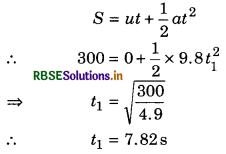
Let time taken by sound to reach the top of tower be t2.
Then, t2 = \(\frac{h}{v}=\frac{300}{340}\) = 0.88 s.
Total time taken for the splash to be heard at the top
= t1 + t2 = 7.82 + 0.88 = 8.70 s
Question 15.3.
A steel wire has a length of 12.0 m and a mass of 2.10 kg. What should be the tension in the wire so that speed of a transverse wave on the wire equals the speed of sound in dry air at 20°C = 343 ms-1?
Solution:
Length of steel wire, l = 12 m
mass of steel wire, M = 2.10 kg
Speed of sound in dry air, v = 343 ms-1
Mass per unit length, m = \(\frac{M}{l}=\frac{2.10}{12}\)
= 0.175 kg m-1
But, v = \(\sqrt{\frac{T}{m}}\)
∴ T = v2m
⇒ T = (343)2 x 0.175
⇒ T = 2.06 x 104 N
Question 15.4.
Use the formula v = \(\sqrt{\frac{\gamma \boldsymbol{P}}{\rho}}\) to explain why the speed of sound in air:
(a) is independent of pressure, (b) increases with temperature, (c) increases with humidity?
Solution:
(a) v = \(\sqrt{\frac{\gamma \boldsymbol{P}}{\rho}}\) ................................(1)
ρ = \(\frac{M}{V}\) .......................(2)
here v = speed of sound in air
V = Volume of gas
M = molecular weight of gas
From (1) and (2),
∴ v = \(\sqrt{\frac{\gamma \boldsymbol{P}}{\rho}}\)
From ideal gas equation,
for n = 1
PV = RT
For constant T,
PV = constant
∵ Both M and γ are constant
∴ v = constant
∴ At constant temperature, the speed of sound in air is independent of the change in the pressure of gas.
(b) For one mole of an ideal gas, the gas equation is:
PV = RT
P = \(\frac{R T}{V}\) ..........................(3)
From (1) and (3),
V = \(\sqrt{\frac{\gamma R T}{V \rho}}=\sqrt{\frac{\gamma R T}{M}}\) ..........................(4)
∴ V ∝ \(\sqrt{T}\)
Thus, the speed of sound in air is directly proportional to the square root of temperature of the gas.
(c) Let vm and vd be the speeds of sound in moist air and dry air respectively. The densities of moist air and dry air be ρa and ρd respectively.
The speed of sound in moist air is
vm = \(\sqrt{\frac{\gamma P}{\rho_m}}\) ..........................(5)
Speed of sound in dry air is
vd = \(\sqrt{\frac{\gamma P}{\rho_d}}\) ......................(6)
Dividing (5) and (6), we get
\(\frac{v_m}{v_d}=\sqrt{\frac{\gamma P}{\rho_m} \times \frac{\rho_d}{\gamma P}}=\sqrt{\frac{\rho_d}{\rho_m}}\) .........................(7)
But, the pressure of water vapour decreases the density of air, so,
ρd < ρm
⇒ vd < vm
Thus, the speed of sound in moist air is greater than that in dry air.

Question 15.5.
You have learnt that a travelling wave in one dimension is represented by a function y = f (x,t) where x and t must appear in the combination x-vt or x+vt, i.e., y = f (x ± vt). Is the converse true? Examine if the following functions for y can possibly represent a travelling wave:
(a) (x- vt)2
(b) log[(x+ vt)/x0]
(c) 1/(x + vt)
Solution:
(a) (x - vt)2
No.
For x = 0 and t = 0, (x - vt)2 = 0
∴ The function represents a point and not wave.
(b) log [\(\frac{x+v t}{x_0}\)]
No
For x = 0 and t = 0,
log \(\frac{x+v t}{x_0}\) = log0 = ∞
Thus, the function does not converge to a finite value for x = 0 and t = 0. Hence, it does not represent a travelling wave.
(c) \(\frac{1}{x+v t}\)
No
For x = 0 and t = 0,
\(\frac{1}{x+v t}\) = ∞
Thus, the function does not converge to a finite value for x = 0 and t = 0. Hence, it does not represent a travelling wave.
Hence, the converse is not true.
Question 15.6.
A bat emits ultrasonic sound of frequency 100 kHz in air. If this sound meets a water surface, what is the wavelength of (a) the reflected sound, (b) the transmitted sound? Speed of sound in air = 340 ms-1 and in water = 1486 ms-1.
Solution:
Frequency, v = 100 kHz = 105 Hz
Speed of sound in air, va = 340 ms-1
Speed of sound in water, vw = 1486 ms-1
Wavelength of reflection sound, λa = \(\frac{v_a}{v}=\frac{340}{10^5}\)
= 3.4 x 10-3 m
Wavelength of transmitted sound,
λw = \(\frac{v_w}{v}=\frac{1486}{10^5}\)
= 1.486 x 10-2 m
Question 15.7.
A hospital uses an ultrasonic scanner to locate tumours in a tissue. What is the wavelength of sound in a tissue in which the speed of sound is 1.7 kms-1? The operating frequency of the scanner is 4.2 MHz.
Solution:
Speed of sound, v = 1.7 kms-1 = 1700 ms-1
Operating frequency of the scanner, v = 4.2 MHz = 4.2 x 106 Hz
Wavelength, λ = \(\frac{v}{v}=\frac{1700}{4.2 \times 10^6}\) = 0.405 mm
Question 15.8.
A transverse harmonic wave or a string is described by y(x,t) = 3.0 sin(36t + 0.018x + π/4)
where x and y are in cm and t in s. The positive direction of x is from left to right.
(a) Is this a travelling wave or a stationary wave? If it is travelling, what are the speed and direction of its propagation?
(b) What are its amplitude and frequency?
(c) What is the initial phase at the origin?
(d) What is the least distance between two successive crests in the wave?
Answer:
(a) Comparing the given equation with that of a plane progressive wave of amplitude r,
y(x,t) = r sin[\(\frac{2 \pi}{\lambda}\)(vt + x) + Φ0] .......................(1)
This indicates that the given equation represents a transverse harmonic wave travelling from right to left. Thus, it is not a stationary wave.
(b) y(x,t) = 3.0 sin[0.018 (\(\frac{36}{0.018}\)t + x) + \(\frac{\pi}{4}\)] ..........................(2)
From equations (1) and (2),
v = \(\frac{36}{0.018}\) = 2000 cm s-1
r = 3.0 cm
\(\frac{2 \pi}{\lambda}\) = 0.018
λ = \(\frac{2 \pi}{0.018}\) cm
Frequency, v = \(\frac{v}{\lambda}=\frac{2000}{2 \pi}\) x 0.018 = 5.73 s-1
(c) Initial phase, Φ0 = \(\frac{\pi}{4}\)
(d) Least distance between two successive crest in the wave = wavelength = \(\frac{2 \pi}{0.018}\) cm
= 349 cm.
Question 15.9.
For the wave described in Q.15.8, plot the displacement (y) versus (t) graphs for x = 0,2 and 4 cm. What are the shapes of these graphs? In which aspect does the oscillatory motion in travelling wave differ from one point to another amplitude, frequency or phase?
Solution:
The transverse harmonic wave is
y(x,t) = 3.0[36t + 0.018x + \(\frac{\pi}{4}\)]
For x = 0
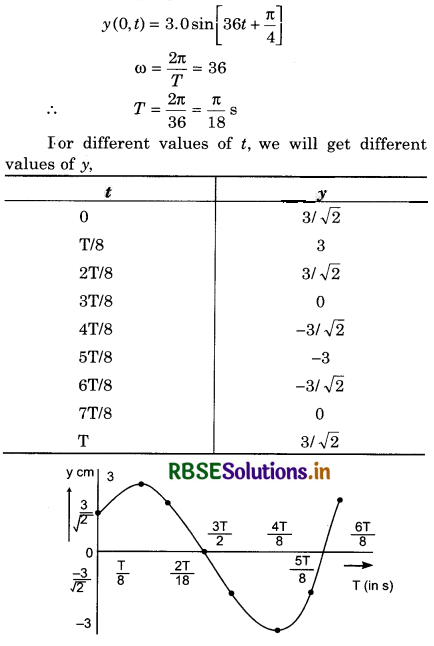
The oscillatory motion in travelling wave difers from one point to another only in phase. Amplitude and frequency remain the same.

Question 15.10.
For the travelling harmonic wave: y(x,t) = 2.0 cos 2π (10t - 0.0080x + 0.35) where x and y are in cm and t in s. Calculate the phase difference between oscillatory motion of two points separated by a distance of
(a) 4 m, (b) 0.5 m, (c) λ/2, (d) 3λ/4.
Solution:
We can write the given equation as:
y = 2.0 cos[2π(10t - 0.0080 x) + 2π x 0.35]
y = 2.0 cos[2π x 0.0080 (\frac{10 t}{0.0080} -x ) + 0.7π]
Comparing it with the equation of a travelling harmonic wave,
y = r cos[\(\frac{2 \pi}{\lambda}\)(vt - x) + Φ0]
\(\frac{2 \pi}{\lambda}\) = 2π x 0.0080
The phase difference, Φ = \(\frac{2 \pi}{\lambda}\)x
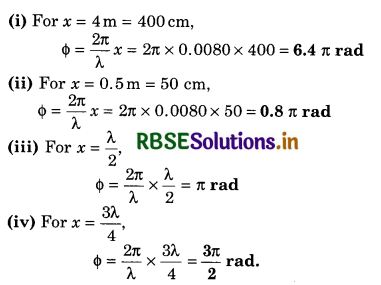
Question 15.11.
The transverse displacement of a string (clamped at its both ends) is given by:
y(x,t) = 0.06 sin(\(\frac{2 \pi}{3}\)x) cos(120πt)
where x and y are in m and t in s. The length of the string is 1.5 m and its mass is 3.0 x 10-2 kg.
Answer the folowing:
(a) Does the function represent a travelling wave or a stationary wave?
(b) Interpret the wave as a superposition of two waves travelling in opposite directions. What is the wavelength, frequency, and speed of each wave?
(c) Determine the tension in the string.
Solution:
(a) It represents a stationary wave because the equation has harmonic functions of x and t separately.
(b) When a wave pulse, y1 = r sin\(\frac{2 \pi}{\lambda}\) (vt - x) which travels along +x axis, and is superimposed by the reflected wave, y2 = -r sin\(\frac{2 \pi}{\lambda}\)(vt - x) which travels along -x axis.
Then the stationary wave y is formed.
y = y1 + y2
y = -2r sin \(\frac{2 \pi}{\lambda}\) x cos \(\frac{2 \pi}{\lambda}\) vt
Comparing it with the given equation,
\(\frac{2 \pi}{\lambda}\) = \(\frac{2 \pi}{3}\)
⇒ λ = 3 m
Also, \(\frac{2 \pi}{\lambda}\)v = 120 π
⇒ v = 60λ = 60 x 3 = 180 ms-1
Frequency, v = \(\frac{v}{\lambda}=\frac{180}{3}\) = 60 Hz
(c) Velocity, v = \(\sqrt{\frac{T}{m}}\)
⇒ v2 = \(\frac{T}{m}\)
⇒ T = v2.m
= (180)2 x 2 x 10-2
= 648 N
Question 15.12.
(i) For the wave on a string described in Q.15.11, do all the points on the string oscillate with the same (a) frequency, (b) phase, (c) amplitude? Explain your answers,
(ii) What is the amplitude of a point 0.375 m away from one end?
Solution:
(i) All the points on the string oscillate with the
(a) same frequency except at the nodes.
(b) same phase except at the node.
(c) different amplitude at different points
(ii) y(x,t) = 0.06sin(\(\frac{2 \pi}{3}\) x) cos(120 πt)
Amplitude (at x = 0.375m) = 0.06 sin \(\frac{2 \pi}{3}\)x x 1
= 0.06 sin\(\frac{2 \pi}{3}\) x 0.375
= 0.06 sin\(\frac{\pi}{4}\)
= \(\frac{0.06}{\sqrt{2}}\)
= 0.042 m
Question 15.13.
Given below are some functions of x and t to represent the displacement (transverse or longitudinal) of an elastic wave. State which of these represent (i) a travelling wave, (ii) a stationary wave or (iii) none at all:
(a) y = 2cos(3x) sin(10t)
(b) y = 2\(\sqrt{x-v t}\)
(c) y = 3 sin (5x - 0.5t) + 4 cos (5x - 0.5t)
(d) y = cosx sint + cos2x sin2t
Solution:
(a) Stationary wave
(b) None at all
(c) Travelling wave
(d) Stationary wave
Question 15.14.
A wire stretched between two rigid supports vibrates in its fundamental mode with a frequency of 45 Hz. The mass of the wire is 3.5 x 10-2 kg and its linear mass density is 4.0 x 10-2 kg m-1. What is (a) the speed of a transverse wave on the string and (b) the tension in the string?
Solution:
Frequency, v = 45 Hz
Mass of wire, M = 3.5 x 10-2 kg
Mass density m = \(\frac{M}{l}\) = 4 x 10-2 kg m-1
(a) ∴ l = \(\frac{M}{m}=\frac{3.5 \times 10^{-2}}{4 \times 10^{-2}} = \frac{7}{8}\) m
\(\frac{\lambda}{2}=l=\frac{7}{8}\)
∴ λ = \(\frac{7}{4}\)m = 1.75 m
Speed transverse wave, v = vλ
= 45 x 1.75
= 78.75 ms-1
(b) v = \(\sqrt{\frac{T}{m}}\)
∴ T = v2m
= (78.75)2 x 4 x 10-2
= 248.06 N

Question 15.15.
A metre-long tube open at one end, With a movable piston at the other end, shows resonance with a fixed frequency source (a tuning fork of frequency 340 Hz) when the tube length is 25.5 cm or 79.3 cm. Estimate the speed of sound in air at the temperature of the experiment. The edge effects may be neglected.
Solution:
There is a piston at one end of the tube. So, it behaves like a closed organ pipe that produces only odd harmonics. So, the pipe is in resonance with the fundamental node and the third harmonic.
\(\frac{\lambda}{4}\) = l1 = 25.5
∴ λ = 4 x 25.5 = 102 cm = 1.02 m
Speed of sound in air, v = vλ
= 340 x 1.02
= 346.8 ms-1
Question 15.16.
A steel rod 100 cm long is clamped at its middle. The fundamental frequency of longitudinal vibrations of the rod are given to be 2.53 kHz. What is the speed of sound in steel?
Solution:
Length of steel rod, L = 100 cm = 1m
Frequency, v = 2.53 kHz = 2.53 x 103 Hz
When the rod is clamped at middle, a node is formed at the middle and antinode is formed at each end.
∴ L = \(\frac{\lambda}{4}+\frac{\lambda}{4}=\frac{\lambda}{2}\)
⇒ λ = 2L = 2 meter
But v = vλ
v = 2.53 x 103 x 2
v = 5.06 x 103 ms-1
Question 15.17.
A pipe 20 cm long is closed at one end. Which harmonic mode of the pipe is resonantly excited by a 430 Hz source? Will the same source be in resonance with the pipe if both ends are open? (Speed of sound in air is 340 ms-1).
Solution:
Length of pipe, L = 20cm = 0.2 m
Speed of sound in air = 340 ms-1
Frequency, v = 430 Hz
Frequency of nth normal mode of closed pipe
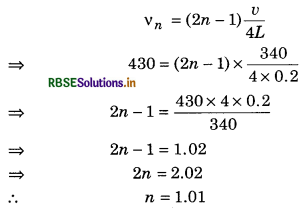
So, it will be the I normal mode of vibration of a pipe with both open ends,
vv = v x \(\frac{v}{2 L}\)
430 = \(\frac{v \times 340}{2 \times 0.2}\)
∴ v = \(\frac{430 \times 2 \times 0.2}{340}\) = 0.5
v should be an integer so, open organ pipe can not be in resonance with the source.
Question 15.18.
Two sitar strings A and B playing the note ‘Ga’ are slightly out of tune and produce beats of frequency 6 Hz. The tension in the string A is slightly reduced and the beat frequency is found to reduce to 3 Hz. If the original frequency of A is 324 Hz, what is the frequency of B?
Solution:
Let na and nb be the original frequencies of sitar string A and B respectively.
Given: Number of beats per second = 6
∴ nb = na ± 6 = 324± 6
∴ nb = 330 Hz or 318 Hz
When tension in string A is decreased, then its frequency also decreases as n ∝ \sqrt{T}.
Now, the beat frequency is reduced to 3. So, frequency of
B = 324 - 6 = 318 Hz
Question 15.19.
Explain why for (or how):
(a) In a sound wave, a displacement node is a pressure antinode and vice versa.
(b) Bats can ascertain distances, directions, nature, and sizes of the obstacles without any “eyes”.
(c) A violin note and sitar note may have the same frequency, yet we can distinguish between the two notes,
(d) Solids can support both longitudinal and transverse waves, but only longitudinal waves can propagate in gases, and
(e) The shape of a pulse gets distorted during propagation in a dispersive medium.
Solution:
(a) A node is a point where amplitude of vibration is minimum and pressure is maximum. While, an antinode is a point where amplitude of vibration is maximum and pressure is minimum. So, a displacement node is a preessure antinode, and vice-versa.
(b) Bats emit very high frequency ultrasonic sound waves. These waves get reflected back towards them by obstacles. A bat receive a reflected wave and ascertain distances, directions, nature and sizes of the obstacles without any eyes.
(c) The overtone produced by a sitar and a violin, and the strength of these overtones are different. So, one can distinguish between the two notes when a violin note and sitar note may have the same frequency.
(d) Solids can support both longitudinal and transverse waves, but only longitudinal waves can propagate in gases because solids have both the elasticity of volume and elasticity of shape, whereas gases have only the volume elasticity.
(e) A pulse of sound is a combination of waves of different wavelengths travelling in a dispersive medium with different velocities, then the shape of the pulse get distorted.
Question 15.20.
A train, standing at the outer signal of a railway station blows a whistle of frequency 400 Hz in still air. (i) What is the frequency of the whistle for a platform observer when the train (a) approaches the platform with a speed of 10 ms-1, (b) recedes from the platform with a speed of 10 ms-1? (ii) What is the speed of sound in each case? The speed of sound in still air can be taken as 340 ms-1.
Solution:
Given: Frequency, v = 400 Hz
Speed of sound in still air = 340 ms-1
(i) Vs = 10 ms-1
V' = \(\frac{V}{V-V_s}\) x v = \(\frac{340}{340 - 10}\) x 400 = 412.12 Hz
(b) VS = 10 ms-1
V' = \(\frac{V}{V+V_S}\) x 100
= \(\frac{340}{340 + 10}\) x 400 = 388.6 Hz
(ii) Speed of sound in each case = 340 ms-1

Question 15.21.
A train, standing in a station yard, blows a whistle of frequency 400 Hz in still air. The wind starts blowing in the direction from the yard to the station with a speed of 10 ms-1. What are the frequency, wavelength, and speed of sound for an observer standing on the station’s platform? Is the situation exactly identical to the case when the air is still and the observer runs towards the yard at a speed of 10 ms-1? The speed of sound in still air can be taken as 340 ms-1.
Solution:
Frequency of whistle, v = 400 Hz
Initial speed of wind, Vm = 10 ms-1
Speed of sound in still air = 340 ms-1
Effective speed of sound when the wind blows in the direction of sound = V + Vm = 340 + 10 = 350 ms-1.
When the source and listener are at rest, the frequency remains same, v = 400 Hz
∴ Wavelength, λ = \(\frac{V+V_m}{v}=\frac{350}{400}\) = 0.875 m
When the air is still, Vm = 0
Speed of observer, VL = 10 ms-1
When, observer moves towards the source,
v' = \(\frac{V+V_L}{V}\) x v
∴ v' = \(\frac{340+10}{340}\) x 400
⇒ v' = 411.76 Hz
When source is at rest, the wavelength remains the same.
∴ λ' = λ = 0.875 m
Speed of sound = V + Vm = 340 ms-1
So, the situation in both the cases is different.
Additional Exercises
Question 15.22.
A travelling harmonic wave on a string is described by
y(x,t) = 7.5 sin (0.0050x+ 12t + π/4)
(a) What are the displacement and velocity of oscillation of a point at x= 1 cm and t = 1s? Is this velocity equal to the velocity of wave propagation?
(b) Locate the points of the string which have the same transverse displacements and velocity as the x= 1cm point at t = 2 s, 5s and 11s.
Solution:
(a) At x = 1 cm and t = 1s,
y(1,1) = 7.5sin(0.005 x 1 + 12 x 1 + \(\frac{\pi}{4}\))
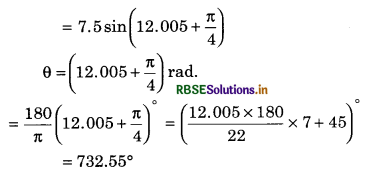
Now, y(1,1) = 7.5 sin(732.55°)
= 7.5 sin(720 + 12.55°)
= 7.5 sin12.55°
= 7.5 x 0.2173 = 1.63 cm
Velocity of oscilation, v = \(\frac{d}{d t}[(y(1,1)]\)
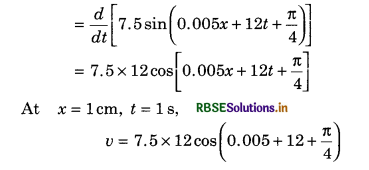
= 90 cos(732.55°)
= 90 cos(720 + 12.55°)
= 90 cos 12.55°
= 90 x 0.9765
= 87.89 cm s-1
Now, comparing the given equation with the standard from,
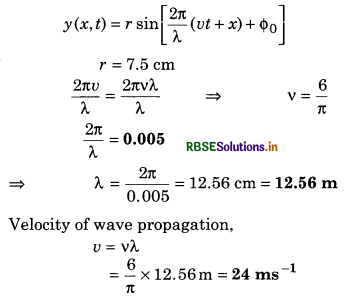
So, velocity at x = 1 cm and t = 1s, is not equal to velocity of wave propagation.
(b) All points that are at a distance of ±λ, ±2λ, ±3λ from x = 1cm will have same transverse displacement and velocity.
λ = 12.56 m, so, all the points at distances ±12.6 m, ±25.2 m, ±37.8 m, ....................... from x = 1 cm will have same displacement and velocity, as x = 1 cm point at t = 2s, 5s, and 1/s.
Question 15.23.
A narrow sound pulse (for example, a short pip by a whistle) is sent across a medium,
(a) Does the pulse have a definite (i) frequency, (ii) wavelength, (iii) speed of propagation?
(b) If the pulse rate is 1 after every 20 s, (that is the whiste is blow for a split of second after every 20 s), is the frequency of the note produced by the whistle equal to 1/20 or 0.05 Hz?
Solution:
The pulse will not have a definite frequency and wavelength, but, its speed of propagation is definite.
(b) No, the frequency of the note produced by whistle is not 1/20 or 0.05 Hz. However, 0.05 Hz is the frequency of repetition of the short pipe of whistle.
Question 15.24.
One end of a long string of linear mass density 8.0 x 10-3 kgm-1 is connected to an electrically driven tuning fork of frequency 256 Hz. The other end passes over a pulley and is tied to a pan containing a mass of 90 kg. The pulley end absorbs all the incoming energy so that reflected waves at this end have negligible amplitude. At t = 0 the left end (fork end) of the string x = 0 has zero transverse displacement (y = 0) and is moving along positive y-direction. The amplitude of the wave is 5.0 cm. Write down the transverse displacement y as function of x and t that describes the wave on the string.
Solution:
Given: Mass density, m = 8.0 x 10-3 kg m-1
Frequency, v = 256 Hz
Tension, T = mg
= 90 x 9.8 = 882 N
Amplitude of wave, r = 5 cm = 0.05 m
The wave propagating along the string is transverse travelling wave. So, the velocity of wave is
v = \(\sqrt{\frac{T}{m}}=\sqrt{\frac{882}{8 \times 10^{-3}}}\)
= 3.32 x 102 ms-1
ω = 2πv = 2 x 3.14 x 256
= 1.61 x 103 rads-1
Wavelength, λ = \(\frac{v}{v}=\frac{3.32 \times 10^2}{256}\)
Propagation constant,
k = \(\frac{2 \pi}{\lambda}=\frac{2 \times 3.14 \times 256}{3.32 \times 10^2}\)
= 4.84 m-1
The wave propagates along +x direction. So, the equation of wave is y(x,t) = r sin (ωt - kx)
= 0.05sin(1.161 x 103t - 4.84 x)

Question 15.25.
A SONAR system fixed in a submarine operates at a frequency 40.0 kHz. An enemy submarine moves towards the SONAR with a speed of 360 kmh-1. What is the frequency of sound reflected by the submarine? Take the speed of sound in water to be 1450 ms-1.
Solution:
Frequency of SONAR, v = 40 kHz = 40 x 103 Hz
Speed of the submarine of enemy, VL = 360 kmh-1
= 360 x \(\frac{5}{18}\) = 100 ms-1
Speed of sound waves in water, V = 1450 ms-1.
The source is at rest and observer moves towards the source. So, the apparent frequency received by the submarine of the enemy,
v' = \(\frac{\left(V+V_L\right) v}{V}=\frac{(1450+100) \times 40 \times 10^3}{1450^{\prime}}\)
= 4.276 x 104 Hz
This frequency is observed by SONAR and reflected by the submarine of enemy. So,
VS = 360 kmh-1 = 10 ms-1,
and VL = 0
Apparent frequency, v'' = \(\frac{V \times v}{V-V_S}\)
= \(\frac{1450}{1450-100}\) x 4.276 x 104
= 4.59 x 104 Hz
Question 15.26.
Earthquakes generate sound waves inside the earth. Unlike a gas the earth can experience both transverse (S) and longitudinal (P) sound waves. Typically, the speed of S wave is about 4.0 km s-1, and that of P wave is 8.0 kms-1. A seismograph records P and S waves from an earthquake. The first P wave arrives 4 min before the first S wave. Assuming the waves travel in straight line, how far away does the earthquake occur?
Solution:
Let the velocities of S wave and P wave be V1 and V2 respectively. Let the time taken by these waves to travel to the position of seismograph be t1 and t2 l is If the distance of occurrence of earthquake from seismograph.
then, l = v1t1 = v2t2
Given: v1 = 4 kms-1, v2 = 8 kms-1
∴ 4t1 = 8t2
⇒ t1 = 2t2
But, t1 - t2 = 4 min = 240 s
∴ 2t2 - t2 = 240 [∵t1 = 2t2]
⇒ t2 = 240 s
t1 = 2t2 = 2 x 240 = 480 s
∴ l = v1t1 = 4 x 480 = 1920 km
So, the earthquake occurs 1920 km away from the seismograph.

Question 15.27.
A bat is flitting about in a cave, navigating via ultrasonic beeps. Assume that the sound emission frequency of the bat is 40 kHz. During one fast swoop directly toward a flat wall surface, the bat is moving at 0.03 times the speed of sound in air. What frequency does the bat hear reflected off the wall?
Solution:
Frequency of sound emitted by bat, v = 40 kHz
By the concet of echo → Both move towards each other
The velocity of source (v0 ) = The velocity of listener (vL)
∴ vL = v0 = 0.03 v
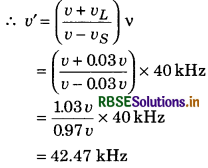

- RBSE Class 11 Physics Important Questions Chapter 4 Motion in a Plane
- RBSE Solutions for Class 11 Physics Chapter 14 Oscillations
- RBSE Solutions for Class 11 Physics Chapter 13 Kinetic Theory
- RBSE Solutions for Class 11 Physics Chapter 12 Thermodynamics
- RBSE Solutions for Class 11 Physics Chapter 11 Thermal Properties of Matter
- RBSE Solutions for Class 11 Physics Chapter 10 Mechanical Properties of Fluids
- RBSE Solutions for Class 11 Physics Chapter 9 Mechanical Properties of Solids
- RBSE Solutions for Class 11 Physics Chapter 8 Gravitation
- RBSE Solutions for Class 11 Physics Chapter 7 System of Particles and Rotational Motion
- RBSE Solutions for Class 11 Physics Chapter 6 Work, Energy and Power
- RBSE Solutions for Class 11 Physics Chapter 5 Laws of Motion